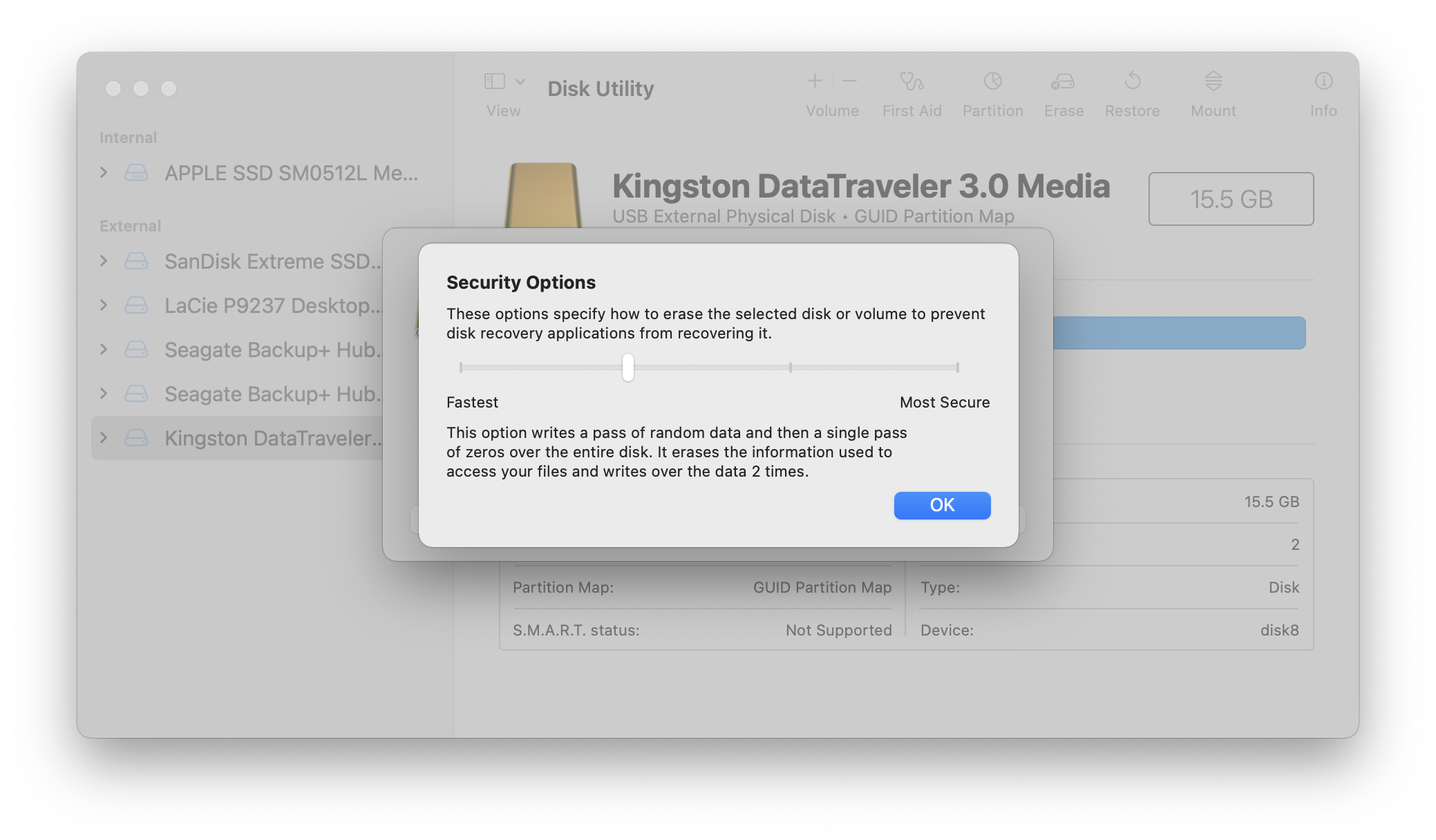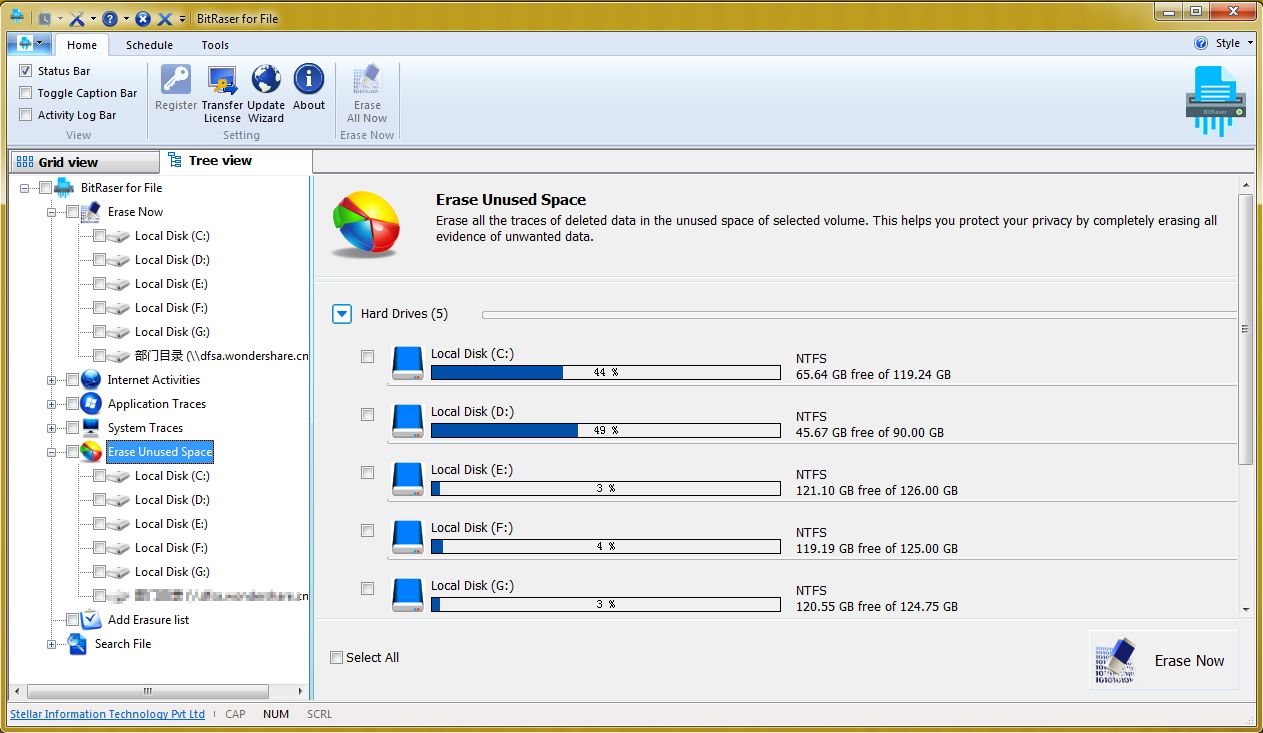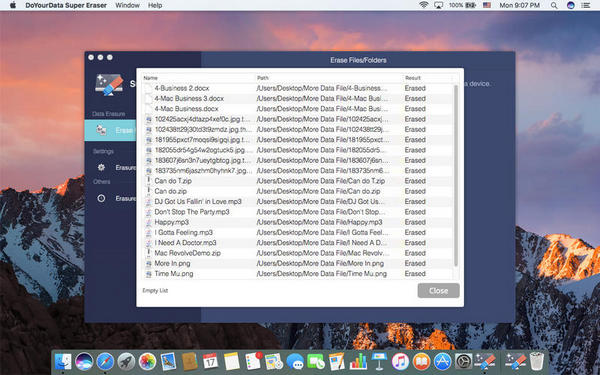In a Mac running on macOS Sierra, High Sierra, Mojave, you'll find a part of the Mac storage space is calculated as purgeable storage. What does purgeable mean on Mac hard drive? And more importantly, with purgeable files taking up a substantial amount of storage space on Mac, you might not be able to download a large file, install macOS update or install a certain app. So how to remove purgeable space on Mac?
Since there is no option on the Mac to find out what purgeable space is or to delete purgeable space, you need the following tips to help you get rid of purgeable storage on Mac.
Here's the video tutorial that explains how to securely wipe the free space on your Mac using Disk Drill.Download for free: https://www.cleverfiles.com/disk. Permanent Eraser 2.1 seems to be a simple shredder. There's no need to do anything but click it, to erase the trash. And, simple drag & drop takes care of file/folders. About the only thing it doesn't do is shred disk (free) space. Also, is it actually using the Gutmann method? 35 passes alone doesn't mean it's Gutmann shredded. If you’re selling an old Mac, a spare hard drive, or you’re just quite paranoid about your deleted data, you’re either familiar with—or should be familiar with—the Erase Free Space button on the Erase tab in Disk Utility (found in your Applications - Utilities folder). When you click this button, you’re presented with three options. I was trying to wipe the free space of an external USB 3.0 disk in OS X (Yosemite) disk utility. However, I receive the following error: EDIT: The disk is formatted as GUID / Mac OS Extended (Journaled) and 1.1 of 2.0 TB are occupied. ShredIt X – Mac OS X; Instructions: How to Erase Free Space. There are three ways to erase free space using ShredIt X. Using Drag and Drop. Drag the Hard Drive icon onto the ShredIt Icon and drop it;. Using the Buttons. Double-click the ShredIt X Icon to start the app. Click the “Shred Freespace” button on the main dialog.
You May Like:
What Is Purgeable Space on Mac?
Purgeable storage space appears when Optimize Mac Storage feature is turned on in About this Mac > Storage.
Unlike Applications, iOS Files and other kinds of storage which allows us to view what files are taking up that storage space, Purgeable storage doesn't list out all the purgeable files on the Mac. So there is no way to find out what exactly Purgeable storage contains.
Generally, as its name has suggested, purgeable space is the storage space holds files that can be purged by macOS when free storage space is needed. Files marked as purgeable can be things such as:
Photos, documents that are stored in iCloud;
Purchased movies and TV shows from iTunes you've already watched and can be re-downloaded;
Large fonts, dictionaries, language files that you may never or rarely use;
System caches, logs, duplicated downloads from Safari ...
Purgeable Space Is Not Really Free Space
The available storage space of your Mac is made up of free space and purgeable space, for example, if you have 10GB free space and 56GB purgeable space on Mac, the total available space is 66GB. Purgeable space is not empty space. In fact, the purgeable files are actually taking up space on your disk. How Purgeable storage works is that when you need to download, for example, a file of 12GB, the macOS system is designed to remove some of the purgeable space to make room for the 12GB that you are going to download.
However, purgeable storage doesn't always work as expected. Sometimes, you find that you can't download a file of 12GB because your Mac says that your disk is almost full and there is 'not' enough disk space, while you can see there is 56GB purgeable space in Storage.

How to Delete Purgeable Space on Mac
It is difficult to clear Purgeable space on Mac because it is the macOS to decide what files are purgeable and when to purge these purgeable files. Users can't control when to delete purgeable storage space on Mac (and Apple suggests that you don't need to delete purgeable storage on Mac manually). However, if you are really troubled by a large amount of storage space that is taken by purgeable data, here are four methods you can try to reduce and clear Purgeable space on Mac.
Use Macube Cleaner to Clear Purgeable Space on Mac (Recommended)
One way to remove purgeable space on Mac is to delete files that may be counted as purgeable. Macube Cleaner can help you with that. The Macube Cleaner cleaner can free up space on your Mac disk by deleting system cached files, logs, duplicate files, large or old files, mail caches/attachments, etc. It makes it simple to remove purgeable files on Mac.
Erase Free Space Mac Meaning
Step 1 Download and install Macube Cleaner on your Mac.
Step 2 Run Macube Cleaner. You should see the usage of storage space, memory space, CPU.
Step 3 You can choose todelete the items that are clogging up your memory space. For example:
- Click Junk Files. You can clean system caches, logs, app caches which may be considered as purgeable by Mac.
- Click Large & Old Files, which may contain large files that are in Purgeable space. Choose all the photos, documents, movies or other files that you don't need and click Clean to remove them.
- Click Duplicate Files, where you can remove duplicated files on Mac to free up Purgeable space.
Just follow the scanned result of Macube Cleaner to clean out all the files that you don't need. After that, go to About this Mac > Storage, you'll be happy to find that you have reclaimed lots of Purgeable space with Macube Cleaner.
Delete Purgeable Space on Mac by Rebooting Your Computer
If you prefer to do the purgeable space deletion manually, an easy way to free up storage space that people usually forget is to restart your computer. You may rarely do this but it can actually reclaim some purgeable disk space that is occupied by system caches or application caches. If you have not rebooted your Mac for a long time, the amount of the purgeable memory can be large. Just click the Apple logo on your top menu bar and tap Restart, you may happy to see more space available on your Mac.
Remove Purgeable Space on Mac by Using Mac Recommendations
Though Apple doesn’t show you what purgeable space is, it also provides options for you to optimize your Mac storage space. Click the Apple logo at the top menu > About This Mac > Storage > Manage, you will see a few recommendations for you to manage the storage space on Mac.
Store in iCloud: This feature helps you transfer purgeable files to iCloud including files on Mac in Desktop and Documents, your photos and messages. Only the recently opened and used ones are saved locally.
Optimize Storage: The iTunes films and TV programs that you have already watched will be removed as the purgeable space.
Empty Trash Automatically: Purgeable files stored in Trash for more than 30 days will be removed.
Reduce Clutter: The files that take up large space on your Mac will be identified and you can manually select and delete to release purgeable space.
Delete Purgeable Space on Mac by Creating Large Files
Since purgeable space won't be removed until macOS thinks that it needs to make free space for new apps or files, some users developed the idea to create enough large files to reclaim the space taken up by purgeable files. Here are the steps.
Step 1 Launch Spotlight and enter Terminal. Open Terminal.
Step 2 In the Terminal window, enter the line: mkdir ~/largefiles and hit Enter. This creates a new folder called 'largefiles' on your disk.
Step 3 Then perform the line: dd if=/dev/random of=~/largefiles/largefile bs=15m, which will create a new file called 'largefile'of 15MB in the largefiles folder. This could take a while. After about 5 minutes, hit Control + C in the terminal window to end the command.
Step 4 Then perform the command like cp ~/largefiles/largefile ~/largefiles/largefile2, which will make a copy of largefile named largefile2.
Step 5 Continue to make enough copies of the large files by running the cp command. Note that you should change the name of to largefile3, largefile4, etc. to make different copies.
Step 6 Keep running the cp command until it returns with a message indicating that the disk is critically low from Mac.
Step 7 Run the command execute rm -rf ~/largefiles/. This will delete all of the largefiles you have created. Empty the files from Trash as well.
Now go back to About this Mac > Storage. You should notice that Purgeable storage is removed or reduced.
Wrap Up
Above are the 4 ways that you can clear purgeable space on Mac. Rebooting your Mac or using Mac recommendations are reliable and easy but may not go deep enough. The Terminal method is a little complicated if you know nothing about command lines. If your free space on Mac is not enough after trying rebooting and recommendations, you can choose to get rid of purgeable storage with Macube Cleaner, which is also simple and more effective.
How to Clean Your Mac's Hard Disk Drive?
SSD (Solid State Drives) is fast, stable, and offers great performance. Unfortunately, compared to HDDs (Hard Disk Drives), the capacity-to-cost ratio is not good. There are, however, methods to free up hard drives to obtain additional capacity for computer systems, including the macOS.
Certain data and files are important, and you will not want to delete or move them. However, some files are redundant and can be removed without consequences. If you know which files you can safely delete, you can free up this space. Although the Windows operating system is known for inefficient clutter, the macOS also produces unnecessary files that take valuable disk space. In this article, we describe some methods on how to clean macOS disk space.

Video showing How to Obtain Free Space on Your Mac's Drive
Table of Contents:
It is recommended to run a free scan with Combo Cleaner - a tool to detect malware and fix computer errors. You will need to purchase the full version to remove infections and eliminate computer errors. Free trial available. Combo Cleaner is owned and operated by Rcs Lt, the parent company of PCRisk.com read more.
Inspect the drive to ensure that the system is running out of free space
Some issues relating to lack of storage might be difficult to determine and can even be a result of fake error logs. So, first, ensure that the system is, in fact, running out of free space. There are two methods to check available space on a hard drive:
1. Access the Apple menu and select About this Mac. Choose the Storage tab.
2. More detailed information can be found within the Disk Utility feature, which is located in the Applications folder under Utilities. Once Disk Utility is launched, select the drive connected to the Mac.
Begin by cleaning Trash
Once you are sure that the drive is actually full, the next step is to simply clean the computer (as if you were cleaning your home: you empty the trash). Open the Finder menu and choose Empty Trash. Bear in mind that some applications, such as Mail, iMovie, iPhoto, and others, have their own Trash. To clean those apps, follow the steps below:
1. Click Mailbox and choose Erase Deleted Items.
2. Select In All Account and Mailbox.
3. Finally click Erase Junk.
Alternatively, to avoid permanently losing your files, choose to archive your emails by following the steps below.
iPhoto
1. Click on iPhoto from the menu at the top of the screen.
2. Choose Empty iPhoto Trash.
iMovie
1. Click on File from the menu on top of your screen.
2. Select Move to Trash or File.
3. Then choose Move Rejected Clipsto Trash.
Clear unnecessary Downloads
The Downloads folder stores all files downloaded from the Internet. Often, these are forgotten after use and continue to use storage space. This is an excellent area to address when looking to free up space on your drive. Delete all redundant Download files.
1. Open Finder.
2. In the sidebar, choose the Downloads folder. Disk image (.dmg) files commonly occupy the most unused storage space.
Remove unused applications
Unused apps in isolation might not take up a great deal of space, but the amount of hard drive storage used by them collectively can be significant. Furthermore, removing apps on Macs is simple, especially those installed through App Store.
1. To delete them, open Launchpad.
2. Click and hold the program's icon you wish to remove.
3. When the icon starts to animate, click the Delete (x) button.
4. To delete any other app, drag the icon to Trash and then empty Trash.
Make space without losing any data
The best way to gain extra space on the Mac is to move non-executable files such as photos, movies, documents, and any large files, to add external storage, for example, an external drive, USB drive, DVD/CD drive, or cloud storage.
Compress large items
Another method to obtain some free space is to compress files. Compressed files remain on the computer but occupy less space. On the other hand, this can be less efficient than deleting or moving files to external storage. To find the largest files on the drive, follow the steps below:
1. Open Finder from the sidebar.
2. Select the Device (the label you provided) and type criteria into the search field.
3. When your search location appears (for example, This Mac), click the Add (+) button.
4. Click the first drop-down menu, and choose Other.
5. Find the logical size option, enable it, and then click OK.
6. Choose the 'is greater than' condition and type the amount (i.e., 50 Mb).
7. To compress items, right-click or hold Control and left-click it, and then select the Compress 'name' option.
If you are using an earlier version of macOS:
Erase Free Space Mac Catalina
1. Click Go from the Finder menu and select Home.
2. Choose File, click Find and open the Find menu.
3. Find the File size option.
4. Choose the 'is greater than' condition and type the amount (i.e., 50 Mb).
5. To compress items, right-click or hold Control and left-click it, and then select the Compress 'name' option.
6. To archive, your emails, open the Mail application and select a folder you wish to archive (e.g., Inbox).
7. Drag it to the desktop. The mbox folder will appear on your desktop.
8. Right-click it or use the Control and left-click combination, and select Compress 'Inbox.mbox'.
9. Now you can delete your messages from Mail.
Delete unnecessary temporary files, system caches, and logs
System stores several System logs and temporary files - deleting them will increase the available space on your drive. To clean the system from this type of file, we recommendCombo Cleaneror other third-party applications.

Secure Erase Free Space Mac
Clear the browser cache storage
Browsers store website data such as cookies and cache information. Cleaning these hidden files might free up storage space. To clean up Safari, simply click Safari on the menu at the top of the screen and select Clear History. Browsers such as Google Chrome and Mozilla Firefox can be cleaned similarly.